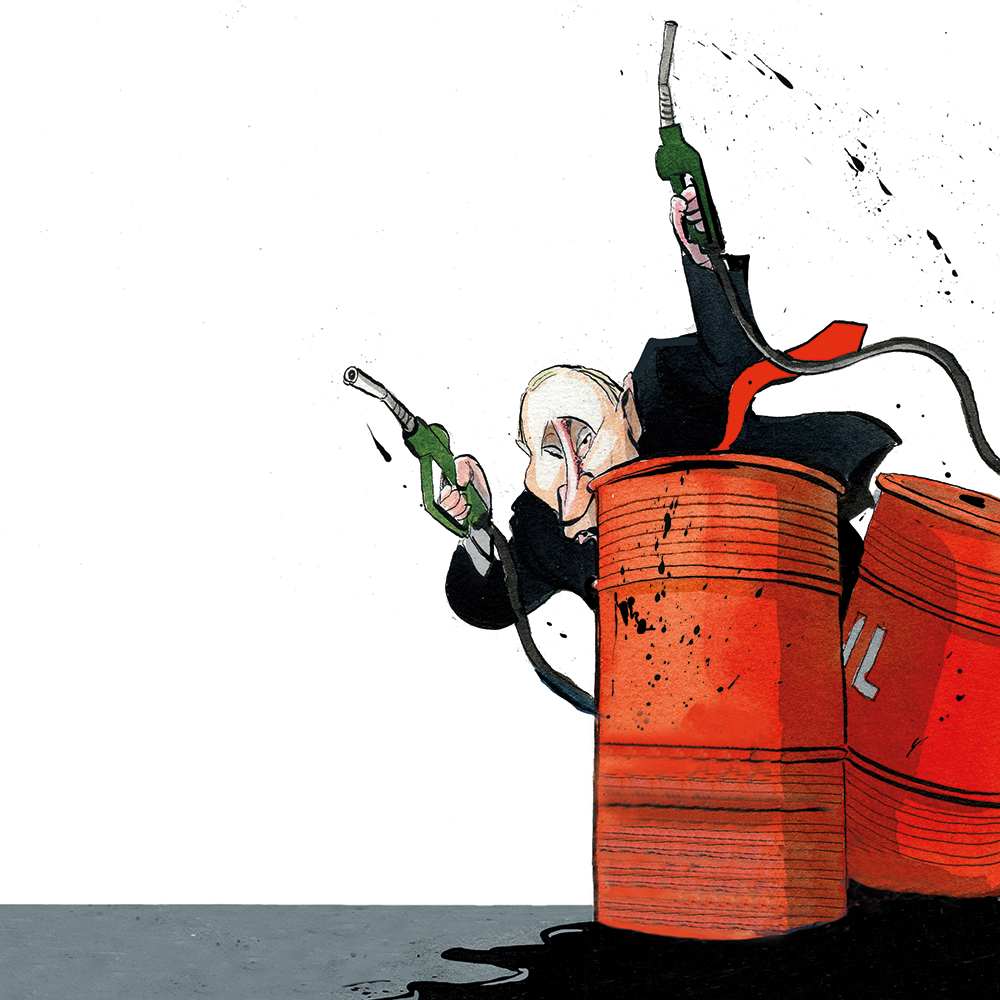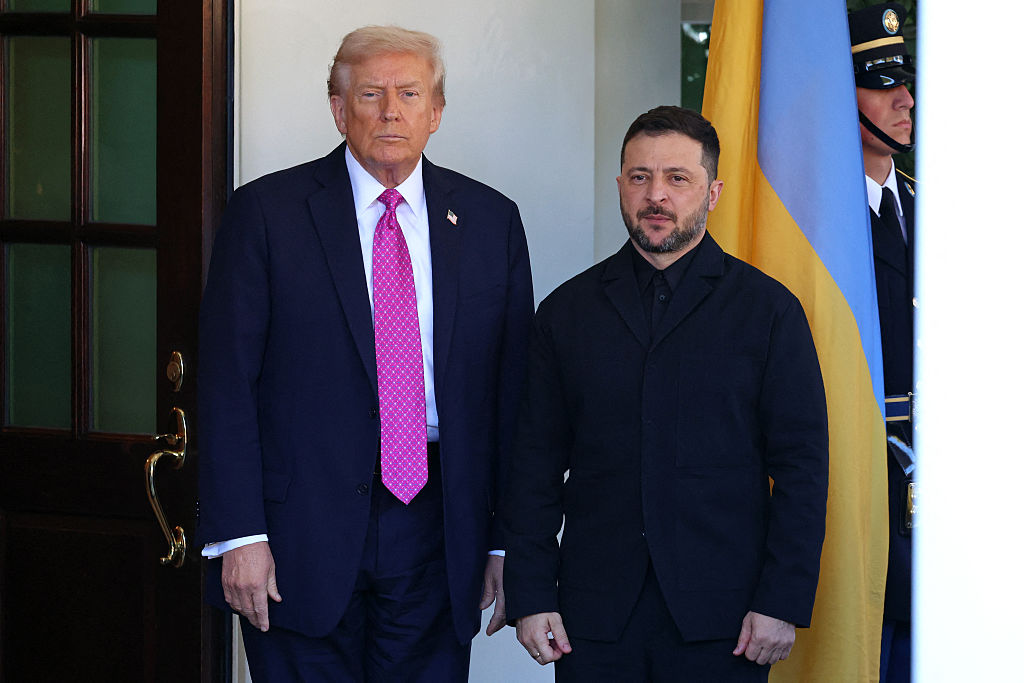Donald Trump is a radical foreign-policy innovator. Over the past few decades, the US has tried a range of non-military means to nudge, squeeze and occasionally strangle its adversaries. These range from travel bans and banking restrictions, to export controls and trade limitations. But never has the US – or indeed anyone – tried to use import tariffs as a species of economic sanction.
Trump has threatened Vladimir Putin with introducing “secondary sanctions” against countries that import Russian oil – a threat intended to strike at the heart of Russia’s war economy. And on August 4, Trump appeared, for the first time, to make good on that threat. To the surprise of diplomats and trade negotiators in Washington and Delhi alike, Trump abruptly announced that he would be imposing a 50 percent tariff on India as a punishment for its importing Russian crude. “India… doesn’t care how many people in Ukraine are being killed by the Russian War Machine,” Trump wrote on social media, blindsiding officials who had been negotiating for months to reduce the $44 billion trade deficit with India. “Because of this, I will be substantially raising the Tariff paid by India to the USA.” US courts have challenged Trump’s right to tariff by executive order – but for the time being the punitive import tax stands.
China and India are the world’s biggest importers of Russian crude, but the EU pays more into Putin’s coffers
India was angry – and baffled. Since the outbreak of war in Ukraine, India has indeed become the second-largest buyer of Russian crude in the world after China. Between March 2022 and May 2023, crude oil from Russia rose from 0.2 percent to 45 percent of India imports. That leap was largely thanks to hefty discounts offered by Moscow that made Urals crude a bargain compared to full-priced oil from India’s traditional suppliers such as Saudi Arabia and Iraq. But buying Russian crude did not violate any US or EU sanctions, which merely fixed the price at $60 a barrel. The intention of the sanctions was to squeeze the revenue Moscow received from oil exports without disrupting the world’s oil supplies. Indeed, in May last year, US ambassador to India Eric Garcetti admitted that India “bought Russian oil because we wanted somebody to buy Russian oil at a price cap; that was not a violation.” The idea was “to ensure the prices did not go up globally,” Garcetti added, and “India delivered on that.”
There have been widespread allegations that Indian buyers have actually been paying amounts over the agreed price cap through various creative accounting tricks known as attestation fraud – for instance by inflating transportation costs or using networks of middlemen to launder the price differential. But the bottom line is that Russia’s war on Ukraine has brought India a major economic windfall in the form of cheap energy for the domestic market and massive profits from re-exporting oil products refined from Russian crude to Europe, with sales worth more than $130 billion per year. India currently supplies 15 percent of Europe’s diesel, for instance, as well as a similar amount of Ukraine’s. And the Indian conglomerate Reliance Industries, whose refinery in Jamnagar is the largest in the world, has seen its stock price jump by 34 percent since 2022.
Will Trump’s dramatic 50 percent tariff on many (though not all) Indian imports to the US force Delhi to stop importing Russian crude? That seems unlikely, since Indian companies are making so much money from refining and reselling Russian oil. India is the world’s fastest-growing economy and has no oil supplies of its own.
The 50 percent tariff on India is double that imposed on most Asian countries. But it is in line with an equally severe rate he applied against Brazil in an attempt to pressure the leadership to end the detention of former president Jair Bolsonaro. But while Trump describes his tax on Indian exports to the US as a “secondary tariff,” in practice there is no such thing. There’s just tariffs with a political label attached.
China and India are indeed the world’s biggest importers of Russian crude. But it’s actually the EU that pays more money into Putin’s coffers. Russia continues to be Europe’s second-largest supplier of liquefied natural gas (LNG). And before Ukrainian attacks on the Druzhba pipeline disrupted supplies last month, Russian crude oil flowed through it and into Slovakia. Yet Europe has not been threatened by Trump – nor for that matter have US allies Turkey and Japan, also major customers of Moscow’s. Europe repeatedly announces its intention to free itself from its fatal addiction to Russian gas. Yet despite 18 packages of sanctions on Russia, there are as yet no actual European restrictions on buying Russian gas.
Brussels has attempted to ban the import of refined oil products originating from Russian crude. But as well as being technically impossible to verify, a long series of carve-outs and exceptions for Canada, Norway, Switzerland, the UK and the US are buried in the small print of every one of the EU sanctions packages.
The paradox that makes both EU and US attempts to sanction Russia incoherent and ultimately toothless is that the West cannot afford to stop Russia from exporting energy. Russia is the world’s second-largest crude oil producer and exporter (after Saudi Arabia), with an output of around 9.5 million barrels a day – nearly 10 percent of global demand. In the immediate aftermath of Putin’s invasion of Ukraine in February 2022, fears of Russian oil being pushed out of the market drove Brent crude prices soaring to $137 a barrel – nearly double today’s prices. Fears of a sharp, energy price-driven recession twisted both the Biden administration and European leaders into the mental pretzel that prevails today. Washington and the EU keep threatening to suffocate the Russian economy, but are in practice unable and unwilling to pay the price of losing Russian oil.
The EU has implemented a new, lower, flexible oil-price cap for Russian crude of $47.60 per barrel, effective from September 3. This floating cap is set at 15 percent below the average market price of Russian Urals blend – but this will affect only European importers. It’s also wide open to fraud – for instance, the Druzhba pipeline carries Kazakh oil as well as Russian, allowing customers to claim they are buying from Kazakh producers.
To date, Ukrainian saboteurs, rockets and drones have been far more effective than EU or US economic sanctions in denting Russian energy exports with attacks on the Nord Stream pipeline in September 2022 and recent raids on Russian oil refineries and oil export terminals. For much of the conflict, the Biden administration consistently blocked Ukrainian attacks on Russia’s oil infrastructure for fear of a price shock. But from the frequency of Ukrainian attacks it now seems those gloves have been taken off (as long as Kyiv doesn’t use US weapons inside Russia).
Fears of an energy-led recession twisted the Biden administration into the mental pretzel that still prevails
Russia’s economy has also, for the first time in the war, officially slid into recession, having shrunk for the past two quarters. But that’s still very far from a deep economic crisis of the kind that could begin to threaten Putin politically. “As long as the war machine of the aggressor does not stop, we must be ready to implement new harsh measures to increase the cost of aggression,” Kaja Kallas, then prime minister of Estonia, told European leaders in March 2022. Days later, Joe Biden also claimed that “the totality of our sanctions and export controls is crushing the Russian economy.”
Yet three and a half years into a war that consumes a staggering 45 percent of Kremlin spending, Russia’s economy is damaged, but far from crushed. Moreover, Putin himself continues to strut the world stage, treading the red carpets laid out for him from Anchorage to Beijing.
It’s time, perhaps, to admit that economic sanctions have failed to change Putin’s behavior or destroy his ability to fight. The reason is that neither Trump nor his allies in the West have been willing to accept the economic pain of imposing any sanctions that could materially hurt Russia.
This article was originally published in The Spectator’s September 15, 2025 World edition.























Leave a Reply